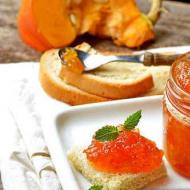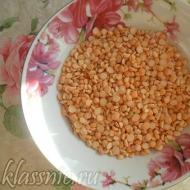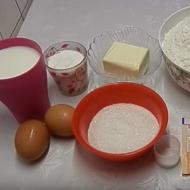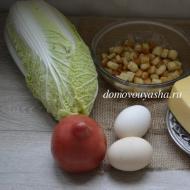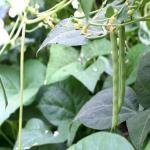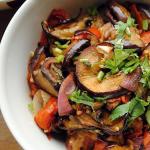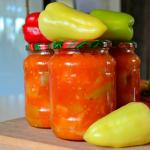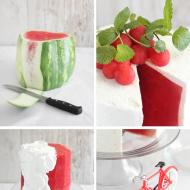
Tomatoes, pickled in jars or pans for the winter: old recipes in a new way. Pickled tomatoes Cooking instructions
Based on the cooking principle, it doesn’t matter in what container you ferment the tomato. You can prepare tomatoes for the winter in a bucket, jar, basin, barrel, and so on. Choose dishes in which it will be convenient for you to do this.
There are also no restrictions on the volume of the selected container.
It is necessary to take a pan with a calculation of the number of vegetables that you plan to ferment. That is, you should not take a five-liter container if you only have one kilogram of tomatoes or, conversely, it is too small for a large volume of vegetables.
You also need to take into account that you will need to place the selected container with already fermented tomatoes in a cold room or refrigerator.
Choose based on the size of the chosen storage space.
Cooking instructions
There are several ways to ferment tomatoes in a saucepan. Next, we will briefly consider the most popular recipes with simple preparation.
IMPORTANT! All recipes are on average designed for a three-liter pan. There may be a slight change in the required number of tomatoes, depending on their size.
With cold water
To prepare you need:
- Medium-sized tomatoes – 2 kg.
- Garlic – 5 cloves.
- Horseradish – 1 leaf.
- Dill inflorescence – 1 pc.
- Currant or cherry leaf – 1 pc.
- Vinegar – 20 ml.
- Salt – 1 teaspoon.
- Sugar – a pinch.
Preparation:
ATTENTION! For fermentation, choose slightly under-ripe vegetables. The crust should be quite dense. Otherwise, you will end up with tomato mush. Also choose fruits without cracks or visible defects.
Now you know how to ferment tomatoes with cold water.
Detailed video about cold sourdough:
With mustard
Ingredients:
- Tomatoes of the same size - 2 kg.
- Dill – 25 g.
- Bay leaf – 3 pcs.
- Currant and cherry leaves - 2 pcs each.
For the marinade:
- Salt - a teaspoon.
- Black peppercorns – 5 pcs.
- Sugar – 2.5 tbsp.
- Mustard powder - teaspoon.
- Water – 1 l.
Preparation:

To prepare the marinade you need:
- To boil water.
- Add salt, sugar and pepper to it.
- After the brine has boiled for five minutes, add mustard.
- Once everything has dissolved, remove the brine from the heat.
- After it has cooled, pour it over the tomatoes.
- Cover the pan with a lid and place in the refrigerator. Preparation time is about two days.
Dry method
To prepare you need to prepare:
- Medium tomatoes – 2 kg.
- Salt – 1 kg.
- Horseradish leaves – 3 pcs.
- Dill umbrellas – 3 pcs.
- Currant and cherry leaves - 6 pcs.
Cooking process:
- Do the same steps with the tomato as with the cold method.
- Place currant, cherry, horseradish leaves and dill umbrellas on the bottom of the pan.
- After placing tightly, place the tomatoes in the pan.
- Place a press on the tomatoes for 24 hours.
- Then place the pan in the refrigerator.
- The appetizer is ready.
Storage
If you wash the vegetables well before fermenting, then if you store the container with the snack in a cool place, they will not spoil for a long time. Pickled tomatoes should always be stored at low temperatures. To do this, place them in the cellar or refrigerator.
Culinary use
 If guests suddenly arrive, you can always get a jar of pickled tomatoes and surprise them with a simple but interesting dish.
If guests suddenly arrive, you can always get a jar of pickled tomatoes and surprise them with a simple but interesting dish.
Tomatoes prepared in this way can become either an independent snack or included in any dishes.
- There is a recipe for pickle soup with the addition of pickled tomatoes.
- You can also add these tomatoes to borscht to suit your taste.
- Pickled tomatoes are a great addition to vegetable salads.
Conclusion
Pickled tomatoes are an excellent independent snack even on the holiday table. Choose a recipe for preparing them that is convenient for you and delight your loved ones with delicious food. However, don’t be afraid to experiment with spices. Perhaps you will have your own unique sourdough recipe. Now you don’t have to worry about preserving the beneficial qualities of the vegetable, since fermentation will preserve them.
If you find an error, please highlight a piece of text and click Ctrl+Enter.
Fermentation is a biochemical method of preservation. The process is based on fermentation, during which carbohydrates are converted into lactic acid. It is this substance that gives the preparations a specific aroma and piquant sourness. But the most important thing is that lactic acid is a powerful natural preservative that blocks the proliferation of harmful microflora.
8 culinary rules
Pickling is one of the oldest methods of preparing vegetables. But unfortunately, over the years, fewer and fewer housewives resort to it. If you want to please your loved ones with a traditional Russian appetizer, you will need eight recommendations on how to prepare pickled tomatoes at home.
- Choose quality tomatoes. They should be dense, fleshy, without dark spots or mechanical damage. For pickling, it is better to choose slightly unripe fruits.
- Protect fruits from cracking. To prevent the peel from bursting, pierce each vegetable with a toothpick. This will also help the fruits to be better salted.
- Select a container. If you can't use a barrel, replace it with glass jars. If large volumes of product are needed, use enamel pans and buckets.
- Prepare the container carefully. The jar, bucket or pan should be washed with baking soda and doused with boiling water. Before adding vegetables, wipe the container dry.
- Don't skimp on the brine. The liquid should completely cover the vegetables.
- Protect the product from mold. You can cover the container with a cloth soaked in vodka, or put an aspen twig, cleared of bark, into the brine.
- Fermentation temperature. The appetizer should be prepared at a temperature no higher than 25°C. Otherwise, pathogenic microflora will begin to form in the brine.
- Observe storage conditions. Pickled tomatoes should be stored at a temperature of 0-5°C. In such conditions, the product can last up to eight months.
You have the right to experiment with a set of spices and herbs, removing some components and adding others. But regarding salt and sugar, you need to strictly adhere to the recipe.
Recipes for pickled tomatoes for every taste
In Rus', housewives fermented tomatoes in huge barrels so that there would be enough snacks for the whole winter. Now that the vast majority of people live in cramped city apartments, the task has become somewhat more difficult. Where can I get a barrel? Where should I store it? Resourceful housewives found nothing better than fermenting tomatoes in jars, buckets and pans.
With garlic and herbs
Peculiarities. Fans of spice will love the recipe for pickled tomatoes with garlic, horseradish and herbs. The bright fresh taste of the products will remind you of summer. And hot spices will help the body survive the fight against colds.
You will need:
- 4 kg of tomatoes;
- horseradish root (about 10 cm);
- two heads of garlic;
- a bunch of parsley;
- dill umbrellas (five for each jar);
- salt (70 g for each liter of water);
- currant and cherry leaves at your discretion.
Preparation
- Wash and dry the tomatoes. Do the same with greens and berry leaves.
- Peel the garlic. If the cloves are too large, cut them in half.
- Peel the horseradish and cut into small slices.
- Place berry leaves, garlic, horseradish and dill at the bottom of the jars.
- Place the tomatoes on top, layering them with leaves and garlic. Place them tightly, but try not to crush them.
- Depending on the density of the tomatoes, you will need 2-3 liters of brine. Dissolve salt in warm water. Strain the liquid through several layers of gauze.
- Fill the jars to the top with brine. Cover the containers with lids, but not tightly.
- Place in a warm place. If after one or two days the liquid in the container ferments, it means the fermentation process has begun. Leave the tomatoes for another five days.
- Place the jars in the refrigerator or any other cold place. Ripe tomatoes will be ready in two weeks, and green ones in a month.
Tomatoes pickled in jars for the winter are prepared without seaming and without sterilization. Close the finished product tightly with a nylon or metal lid. At the right temperature, the product will last a long time, and its taste will only improve over time.
With mustard
Peculiarities. The tomato itself has a bright and rich taste. But even such a fragrant vegetable always wants to be given some new shades. Sour tomatoes with mustard for the winter in jars are an original snack with a very unusual taste. Additional sharpness ensures better preservation of the product.
You will need:
- 3.5 kg of tomatoes;
- three cloves of garlic;
- 10 g grated horseradish;
- liter of water;
- 60 g salt;
- 30 g mustard powder;
- 20 g honey;
- two dill umbrellas;
- two bay leaves;
- carnation inflorescence;
- ten coriander grains;
- eight black peppercorns;
- five peas of allspice.
Preparation
- Place spices, garlic, dill and horseradish in the bottom of the jar.
- Pack the tomatoes as tightly as possible.
- Dissolve half the mustard, honey and salt with water. Pour the marinade over the tomatoes.
- Place gauze or cotton napkin on the container and sprinkle the remaining mustard on top.
- Leave the workpiece at room temperature for ten days.
- Seal the jar with a lid and place in the refrigerator. In a couple of weeks the product will be ready.
If you are worried about the safety of the product, add aspirin. One tablet is enough for a liter jar. The drug will not only kill germs, but will also help keep the tomatoes elastic.
In a bucket
Peculiarities. In the old days, it was customary to ferment vegetables in large barrels. Unfortunately, in city apartments there are neither barrels nor conditions for storing them. Therefore, if you want to prepare the product in large volumes, use a 12 liter enamel bucket. The taste of the snack will be as aromatic as a barrel one.
You will need:
- 8 kg of tomatoes;
- 5 liters of water;
- a glass of salt;
- half a glass of sugar;
- two heads of garlic;
- ten dill umbrellas;
- five sweet peppers;
- three onions;
- 20 peas each of black and allspice;
- ten bay leaves;
- ten horseradish leaves.
Preparation
- Cut the onion into half rings and the sweet pepper into large strips.
- Place a layer of leaves, spices, onions and peppers at the bottom of the bucket. On top are tomatoes. Alternate layers until the bucket is full.
- Dissolve dry ingredients in water. Pour brine over the tomatoes.
- Cover the bucket with clean gauze and a large plate on top. Place a pressure, which can be a bottle of water. Change the gauze periodically.
- Place the bucket in a cool place. When the brine acquires a pleasant sour taste, you can begin tasting.
Always place large and unripe tomatoes at the bottom of the bucket. This way they will be better salted.
Stuffed
Peculiarities. Stuffed tomatoes are the best option for snacks. The products will be well saturated with each other’s flavors, and the brine will give them softness and additional piquancy.
You will need:
- 5 large tomatoes;
- two bell peppers;
- three cloves of garlic;
- a bunch of parsley;
- 15 g salt;
- 50 g sugar;
- 40 ml vinegar;
- 0.5 liters of water.
Preparation
- Make cross-shaped cuts in each tomato.
- Finely chop the pepper, herbs and garlic or grind in a blender. Stuff the fruits.
- Mix water with bulk ingredients and boil.
- Place the stuffed tomatoes in a bowl, cover with a plate and place pressure. Leave for two days at room temperature.
- Transfer the tomatoes to the refrigerator. In a day the dish will be ready. This product can be stored for a week.
Methods for harvesting green fruits
It happens that due to the vagaries of nature, the harvest is in jeopardy. An unexpected cold snap can cause tomatoes to simply refuse to ripen. But don’t let the harvest go to waste! You can collect unripe fruits and wait until they reach home. You can also prepare pickled green tomatoes for the winter.


Hot
Peculiarities. The main disadvantage of pickled green tomatoes is the cooking time. Typically, you need to wait at least a week to enjoy the savory snack. For such impatient gourmets, a recipe for instant pickled tomatoes has been invented. The only drawback of this snack is that it can be stored for no more than seven days.
You will need:
- 3 kg of tomatoes;
- a bunch of celery;
- head of garlic;
- two tablespoons of dill seeds;
- the same amount of salt;
- the same amount of sugar.
Preparation
- Wash the tomatoes, remove the stalk, and also cut out the place where the fruit attaches to the stalk. This is one of the main conditions for quick fermentation.
- Place fruits, garlic cloves, chopped celery and dill in a jar.
- Boil water, add bulk ingredients. Continue heating the liquid until the crystals dissolve.
- Pour the brine into a jar, cover the container with a plate and leave in a warm place for three days.
- During this time, the brine should become cloudy and ferment. Try it. If the liquid has acquired a pleasant sour taste, close the jar with a nylon lid and put it in the refrigerator.
- In one or two days the snack will be ready.
To prevent vegetables from falling apart when they come into contact with boiling water and become even more fragrant, it is necessary to “seal” the hole that was formed when cutting the cuttings. This can be done using a small piece of garlic.
Cold
Peculiarities. Cold pickling of tomatoes helps preserve the structure and benefits of the fruit as much as possible. But you will have to wait at least three weeks for the product to be ready. Tomatoes pickled in a saucepan will be saturated with the aroma of spices and get rid of their specific bitterness.
You will need:
- 5 kg of tomatoes;
- 250 g sugar;
- 50 ml vinegar;
- a bunch of herbs (dill, parsley, tarragon);
- ten currant leaves;
- ten cherry leaves;
- head of garlic;
- salt (70 g for every liter of water).
Preparation
- Place half of the berry leaves and spices on the bottom of the pan.
- Place the tomatoes in a container. If you like whole tomatoes, make a small cross-shaped cut in them. You can also ferment the fruits in halves or pieces.
- Cover the workpiece with the remaining leaves.
- Dissolve salt and sugar in water. Strain the liquid and add vinegar.
- Fill the workpiece with brine and place it under pressure in a cold place. After three weeks you can start tasting.


Dry
Peculiarities. The dry method does not involve the use of brine. During the ripening process, the tomatoes themselves will begin to release juice, in which they will be salted. The taste of the product is as natural as possible and very piquant.
You will need:
- 4 kg of tomatoes;
- six cloves of garlic;
- four cherry leaves;
- four leaves of horseradish;
- six cabbage leaves;
- 60 g sugar;
- 20 g salt.
Preparation
- Wash the tomatoes and remove the stem. Prick each fruit with a toothpick or fork.
- Place the cabbage leaves in boiling water for five minutes to soften them.
- Place the tomatoes in a bucket, layering them with spices and berry leaves. Sprinkle foods with salt and sugar.
- Cover the top with cabbage.
- Place the tomatoes under pressure in a cold place for a day.
- If the fruits have released juice, put them under pressure again and leave for two to three weeks.
- If there is no juice, you will have to add brine prepared at the rate of 70 g of salt per liter of water.
Green tomatoes contain a toxic substance called corned beef, which is neutralized when ripened. If you still fear for the safety of your loved ones, first soak the fruits in salt water for seven to eight hours.
In ancient times, people sincerely believed in omens that permeated all areas of life, including cooking. So, you need to pickle vegetables only in a good mood, otherwise the snack will turn out bitter. You should also not ferment vegetables during the full moon. Workpieces made during this period will be too soft and will quickly deteriorate. If you want tomatoes pickled for the winter to turn out tasty, follow the recipe and follow folk wisdom.
Add recipe to favorites!
Pickled tomatoes - traditional Russian appetizer, which is welcome at any table. When I hear the word “fermented,” I remember my grandmother’s cellar with the ceiling hung with bunches of grapes (in this form they could be stored until spring), with shelves on which were crowded delicious jars of jams and marinades, bunches of onions, garlic, and other various supplies for winter. In the center of all this abundance there was always a huge barrel of pickled vegetables and fruits. They fermented everything that was fermented in it: apples, watermelons, tomatoes, cucumbers, cabbage - everything in one barrel. What a delicious treat it was! It’s a pity that it’s impossible to organize such a barrel in a city apartment, although you can ferment vegetables in a three-liter jar - it’s simple and no less tasty.
You will need:
- 25 tomatoes (small)
- salt 3 tbsp. l (with slide)
- sugar 1 tbsp. (without slide)
- water 1.5 liters
- bay leaf 2-3 pcs
- garlic 1 head
- allspice peas
- black peppercorns
- dill umbrellas
- hot pepper
You will also need a three-liter jar or enamel pan. I like the jar better because... It is more convenient to store it in the refrigerator.
Step-by-step photo recipe for making pickled tomatoes:
Prepare: Bring water to a boil with salt, sugar and bay leaf. Cool.
Wash the jar and tomatoes. Place at the bottom of the jar spices And garlic. If you don't have dill umbrellas, you can add dry dill seeds. If you like it spicy, add hot pepper (half or tip).
Pour in cold brine and leave at room temperature for 3-4 days.
During this time, the fermentation process will begin in the jar, i.e. fermentation using lactic acid bacteria. Unlike, which ferments very actively, tomatoes will not boil. A white film may form on the surface, which should be removed with a spoon and discarded.
After three days, cover the jar with a lid and remove refrigerate for 5-7 days, after which the appetizer that is always welcome on the Russian table is ready. The longer the tomatoes sit in the refrigerator, the brighter and richer their taste will be. Bon appetit!
How to cook cabbage, sauerkraut in a jar, look

Prepare the brine: bring water with salt, sugar and bay leaf to a boil. Cool.
Place spices and garlic at the bottom of the jar. Place the tomatoes in a jar, fill with cold brine and leave at room temperature for 3-4 days. After three days, cover the jar with a lid and put it in the refrigerator for 5-7 days, after which the snack is ready. The longer the tomatoes sit in the refrigerator, the more sour and brighter their taste will be.
Pickled vegetables are useful and necessary for humans for the normal functioning of the digestive system. Tomatoes are especially popular. They are not at all difficult to subject to the fermentation process. They are tasty, attractive in appearance and have a pleasant aroma. It is necessary to prepare pickled tomatoes for the winter in the summer in order to maintain and strengthen the immune system during dangerous periods of seasonal diseases.
Advantages and disadvantages of pickling
The advantage of the fermentation method over other methods of preparing tomatoes for a long time is that a large amount of vitamins is preserved in this way. Lactic acid, which is formed in the process and at the same time is a natural preservative, is beneficial for the body. But consumption of fermented foods should still be in moderation. They should only be used as an appetizer and not as a separate dish.
You need few ingredients to make pickled tomatoes; they are all readily available: in the store or in the garden. The technology itself is also simple. All that remains is to steal some time from your busy schedule and start preparing tomatoes for the winter.
Food preparation
Firm, slightly unripe tomatoes are suitable for pickling. Very green specimens are also suitable for harvesting. The taste of this dish is original and the appearance is pleasant. A variety of oblong tomatoes similar to plums is very popular. They are hard and retain their shape during fermentation.
Fruits must be sorted by size. It is better that the jar contains specimens of the same species. This also applies to the color of vegetables. You should not put both red and green fruits into containers. Ripe ones will ferment much faster than unripe ones.
The tomatoes are thoroughly washed under running water, wiped dry and punctures or small cuts are made in several places to prevent them from “exploding” when pouring hot brine.
It is important that there is no white stem inside the tomato. The pulp should be homogeneous.
Brine can be prepared in different ways, but there are some rules: for 2 liters of water you need to take 2 tablespoons. salt with a slide. To improve the taste of the product, sugar is added to the liquid. It is taken at the rate of: half a glass of sand for 2 kg of tomatoes. It is difficult to guess how much brine will be needed for the quantity of tomatoes harvested. Therefore, it is better to make it with a reserve.
Pickling methods
Previously, tomatoes were fermented in barrels. They were stored in a large, cool cellar. Nowadays, many continue this tradition, but those who do not have this opportunity try to prepare the product in other ways. You can ferment vegetables directly in jars or pans, as well as in a bucket.
In banks
The most acceptable option for city residents is pickling tomatoes in jars. Convenient to prepare and store. Glass containers should be washed thoroughly with baking soda and doused with boiling water.
Cold way
A simple and time-consuming method.
- Place selected tomatoes of the same size in jars, add various spices: bay leaf, garlic cloves, dill, allspice. It is also worth adding cherry or oak leaves.
- Prepare a brine from warm water and salt. Pour the contents of the glass container into it.
- Cover the jars with lids and leave for 12 days in a warm place.
- Then add brine to the container and roll up the lids. Send the product to a cool place until winter.
Hot way
- Spices and various additives are first placed in sterilized jars. This could be: horseradish leaves or root, peppercorns, dill and garlic.
- A brine is prepared from water and salt. It boils for 5 minutes and infuses. When hot, it is poured into jars up to the middle of the volume.
- Tomatoes are laid out on top. The final layer is fragrant sprigs of greenery. Then the brine needs to be added to the very neck of the jar.
- The container is turned upside down and left for 3 days. Then put it in a cool place.
After a month you can try the snack. You can also place a plate of pickled tomatoes, prepared with your own hands, on a festive table.
Instant cooking
It’s always nice when preparations require a minimum of financial costs and time. In the case of quick cooking of tomatoes, you will need very few ingredients.
- Spices and tomatoes are placed in prepared, sterilized jars.
- You definitely need to put dill umbrellas and garlic on top.
- Pour hot brine over the contents. You can prepare it by diluting and boiling salt and sugar in water.
- Close the containers with lids and let stand for a day in a warm place. After this, take it to the cellar or put it in the refrigerator.
Experienced housewives must pierce each fruit where the stalk grows; this will prevent the vegetables from cracking when boiling liquid is poured into them.
In a saucepan
An alternative to glass containers is a saucepan. It is very convenient to place tomatoes in it. It is important to remember about the temperature regime. When the fermentation process is underway, the temperature should be approximately 16-22 degrees. If you go beyond these limits, the technology may break down and you won’t get pickled tomatoes. After fermentation is complete, the product is sent to the refrigerator.
Stuffed pickled tomatoes
A very beautiful dish and very easy to make. The filling for tomatoes can be made from any vegetables, but carrots and bell peppers are most often used. Add spices and herbs to taste. Here is a very popular recipe.
- The tops of prepared, well-washed tomatoes must be cut off. Carefully scrape out the seeds and all the pulp.
- Peel the bell pepper and cut it into small pieces. Grate the carrots on a fine grater, squeeze the garlic through a press, and chop the greens.
- Mix all ingredients for the filling and add salt. For those who like spicier snacks, you can add hot pepper.
- Stuff the tomatoes with the mixture and cover with the cap that was cut off before.
- Place all vegetables, lids up, in a saucepan. Place a plate on top and put pressure on it.
- Tomatoes need to be filled with brine consisting of water, sugar and salt. Do this so that the liquid completely covers the plate.
- Leave for a couple of days at room temperature, then put in the refrigerator.
You can stuff not only ripe tomatoes, but also green ones. This original appetizer will surprise and delight all guests.
- Only hard fruits should be selected for pickling. The “cream” variety is suitable. Vegetables can be unripe, of absolutely any color: red, orange or green. On the contrary, such a multi-colored assortment will look very impressive on the table.
- If you take overripe, soft vegetables, they will turn into mush and take on a completely unattractive appearance.
- All copies should be sorted by size. In this case, they will ferment evenly.
- When choosing spices for preparation, you can show your imagination: in addition to the usual dill and garlic, add rosemary, celery and mint. They will make the taste and aroma of pickled tomatoes piquant and interesting.
- Each fruit must be pierced in several places with a toothpick or a small incision made.
- The brine in the jars should completely occupy the entire space and cover the tomatoes.
- Horseradish leaves are used to prevent the formation of mold on the product.
- Cherry and currant leaves are used to strengthen the fruit.
- Fans of spicy tomatoes add mustard and red hot pepper when fermenting.
Pickled tomatoes can be stored for no more than 8 months. The best place for this is a cellar or refrigerator.


